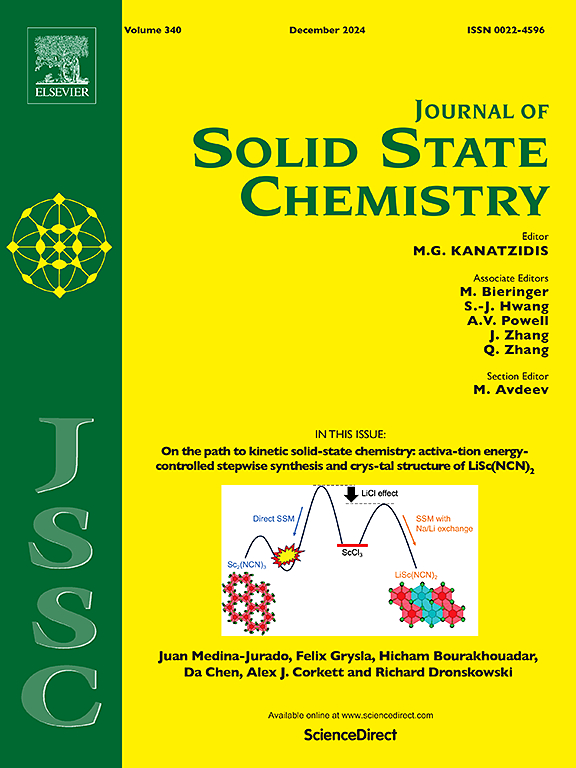Band Gap Tuning in Inorganic Chlorine-Based Halide Perovskites Via Solid-State Synthesis at Room Temperature
IF 3.2
3区 化学
Q2 CHEMISTRY, INORGANIC & NUCLEAR
引用次数: 0
Abstract
Inorganic chlorine-based halide perovskites have emerged as promising materials in optoelectronics and photovoltaics due to their high electron mobility and tunable optical properties. However, traditional solution-based synthesis methods for these perovskites face significant challenges, such as poor solubility, environmental sensitivity, and scalability issues. This paper introduces an energy-efficient, environmentally friendly approach using ball-milling for room-temperature solid-state synthesis of inorganic chlorine-based halide perovskites with variable band gaps, including CsCdCl3 (4.72 eV) and mixed chlorine systems CsPbBr2Cl (2.58 eV) and CsPbCl2Br (2.40 eV). This solid-state method not only effectively overcomes the limitations of solution-based synthesis, including the need for toxic solvents and significant environmental impact, but also enables precise band gap tuning and yields materials with excellent phase control, high purity, and stability. The stability of the resulting materials was evaluated by X-ray diffraction (XRD), X-ray photoelectron spectroscopy (XPS), UV-Vis, and photoluminescence (PL). The results show remarkable stability for up to 90 days when stored in air at room temperature. Utilizing the room-temperature solid-state approach to synthesize chlorine-based halide perovskites not only overcomes the limitations of traditional methods but also paves the way for the development of advanced optoelectronic devices.

室温固相合成无机氯基卤化物钙钛矿带隙调谐
无机氯基卤化物钙钛矿由于其高电子迁移率和可调的光学性质而成为光电子学和光伏学中有前途的材料。然而,传统的基于溶液的钙钛矿合成方法面临着重大挑战,如溶解度差、环境敏感性和可扩展性问题。本文介绍了一种节能环保的室温固相合成方法,该方法采用球磨法合成了具有可变带隙的无机氯基卤化物钙钛矿,包括CsCdCl3 (4.72 eV)和混合氯体系CsPbBr2Cl (2.58 eV)和CsPbCl2Br (2.40 eV)。这种固态方法不仅有效地克服了基于溶液的合成的局限性,包括需要有毒溶剂和显著的环境影响,而且还可以精确地调谐带隙,并产生具有出色的相位控制,高纯度和稳定性的材料。通过x射线衍射(XRD)、x射线光电子能谱(XPS)、紫外可见光谱(UV-Vis)和光致发光(PL)评价了材料的稳定性。结果表明,在室温下储存在空气中,稳定性可达90天。利用室温固相法合成氯基卤化物钙钛矿不仅克服了传统方法的局限性,而且为先进光电器件的发展铺平了道路。
本文章由计算机程序翻译,如有差异,请以英文原文为准。
求助全文
约1分钟内获得全文
求助全文
来源期刊

Journal of Solid State Chemistry
化学-无机化学与核化学
CiteScore
6.00
自引率
9.10%
发文量
848
审稿时长
25 days
期刊介绍:
Covering major developments in the field of solid state chemistry and related areas such as ceramics and amorphous materials, the Journal of Solid State Chemistry features studies of chemical, structural, thermodynamic, electronic, magnetic, and optical properties and processes in solids.
 求助内容:
求助内容: 应助结果提醒方式:
应助结果提醒方式:


